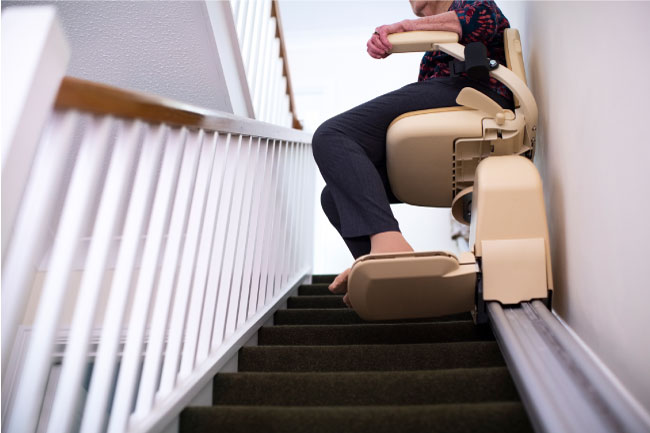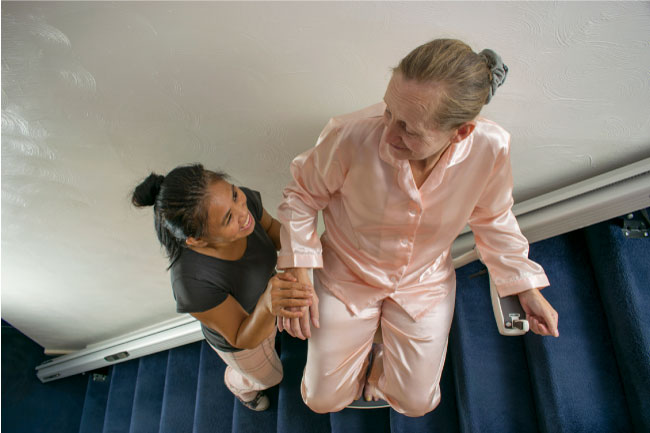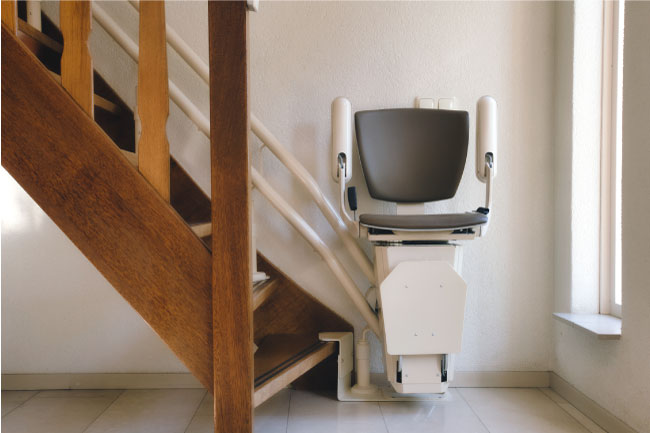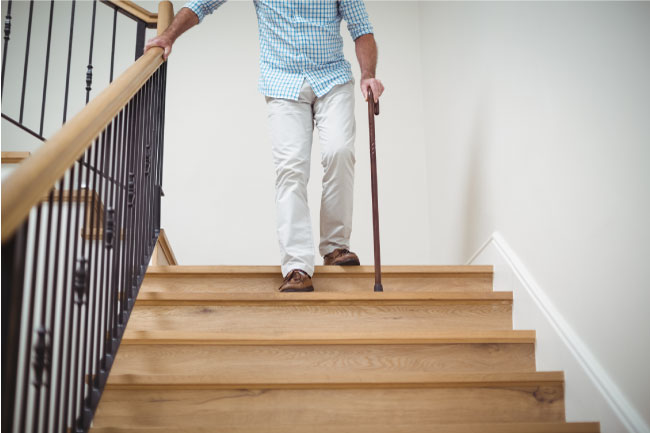
For most seniors, mobility equals independence. Many of the people who enter assisted living each year do so because they have problems moving about safely inside their homes. Stairs represent a particular challenge because senior falls are dangerous – sometimes deadly.
A stair lift can help seniors age-in-place comfortably and safely. Unfortunately, traditional Medicare plans do not cover stair lifts. However, some Medicare Advantage recipients may get help covering the cost of a stair lift depending, on their policies.
Learn more about how to choose a stair lift, how to pay for it, and how to improve stair safety in your home.
Types and Cost of Stair Lifts

While they can be expensive, stair lifts do generally cost less than extensive home renovations like a home elevator or renovating a downstairs room to serve as a bedroom suite.
Typically, a standard stair lift that travels a straight-line staircase costs between $2500 and $5,000, depending on the length of the stairs and options selected. Stair lifts for curved staircases or staircases with intermediate landing are usually custom-made for that particular structure. Prices for custom models start at about $7500. Stair lift prices usually include installation and at least a one-year warranty.
You can save 30% or more by purchasing a refurbished stair lift. However, as with most used appliances, the key here is “buyer beware!”
- Size and Fit: Make sure the stair lift will fit on your staircase. It may not be returnable. This is particularly important if you have a curved staircase, because most of those require custom designs.
- Installation: Ask the seller about certified installers. You want to make sure everything is installed properly, tested, and safe to use.
- Age: Look for a used model that’s no more than 2 years old. Otherwise, you may have to spend a lot on repairs or replace it sooner than expected.
- Warranty: Only purchase factory-certified refurbished stair lifts that are backed by a manufacturer guarantee. A purchase from a third-party supplier could leave you with an inoperable stair lift and no recourse.
If you want to literally test-drive your stair lift chair before committing to purchase, or if you just need a stair lift for a short period, consider a rental. Prices for rented stair lifts generally range from $200-$500 a month, and rental periods usually start at 3 months. Expect to pay an installation fee, but most companies offer a discount if you decide to purchase. Some even apply your installation and rental payments to the purchase price.
Will Medicare Pay for my Stair Lift?

Standard Medicare views stair lifts as assistive devices used mainly for personal comfort or convenience, so they aren’t covered by Medicare or Medicare supplemental (Medigap) plans.
However, a change in the law governing Medicare Advantage plans in 2019 allowed increased supplemental coverage for vision, dental, hearing, non-skilled in-home care, and more. In 2020, the law further expanded coverage and included items intended for “daily maintenance.” There’s certainly a case to be made that, for many people, a stair lift isn’t just a “convenience;” it’s a requirement for their health and safety at home.
Check your Medicare Advantage policy, and remember your doctor must certify that the stair lift is “medically necessary” for it to be covered.
Remember that the Veterans Administration, Medicaid, and some state assistance programs will provide stair lifts or provide partial financial assistance to help you cover the cost. Learn more about how to pay for your stair lift.
Tips to Improve Stair Safety

Stair safety isn’t just an issue for seniors. More than a million people injure themselves in stair falls each year, mainly older adults and younger children. Fortunately, it’s easy to improve stair safety with these affordable, commonsense additions:
- Check for adequate lighting: Use low-glare overhead lighting at the top and bottom of the staircase. Install two-way light switches at the top and bottom of the stairs so that the entire staircase can be illuminated at one time.
- Install carpet or a runner: Stairs made of a slick surface like wood or tile are slipping hazards for everyone. If you can’t install carpet or a runner (because it’s a rental, for example), use non-skid tape on each tread.
- Test the handrails: Make sure the handrails are sturdy and capable of supporting an adult’s entire weight. Handrails on both sides of the stairs are ideal, but may not work on narrow staircases in older homes.
- Keep stairs free of clutter: Items like books, toys, laundry, etc. are often left on stairs as a reminder to take them up or down, but they’re a tripping hazard. It’s better to place a “clutter basket” at the top and bottom of the stairs to hold those items.
No matter how many precautions you take though, accidents can happen anytime, anywhere. A medical alert button or home security system with help buttons allow you to call for help in an emergency. Our GetSafe medical alert system offers peace of mind without the need to wear a necklace or wristband. Call for help by pulling a cord, pushing a button, or simply telling the system to “Call 9-1-1.”
Call us at 1-888-799-6255 to learn more.







